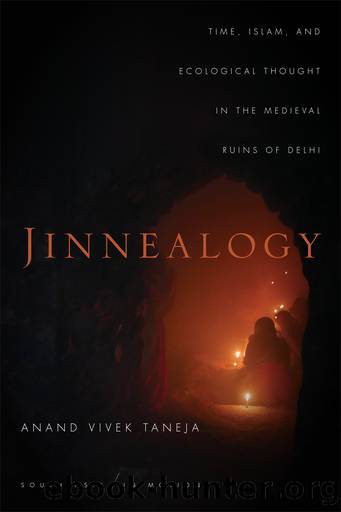Jinnealogy by Taneja Anand Vivek

Author:Taneja, Anand Vivek [Taneja, Anand Vivek]
Language: eng
Format: epub
Publisher: Stanford University Press
Published: 2017-02-14T16:00:00+00:00
CHAPTER 6
STONES, SNAKES, AND SAINTS
Remembering the Vanished Sacred Geographies of Delhi
Qafas men mujh se rudad-e chaman kehte na dar hamdam
Giri hai jis pe kal bijli woh mera ashiyan kyon ho?
In the cage, donât be afraid of telling me the events of the garden, friend
The one on which lightning fell yesterday, why would it be my nest?
âMirza Asadullah Khan Ghalib
THE SHRINE OF THE STONE SAINT
One day, following in the footsteps of Ashiq Ali and Manohar Lal, a friend and I went to the dargah of Ashiq Allah, in the protected forest north of Mehrauli. On our way back to Mehrauli, we came across a large outcropping of rock, just outside the circuit of the ruined, overgrown walls of Qila Rai Pithora. A large boulder, some of it daubed with green paint, was balanced naturally on this outcropping, and with some effort the boulder could be rocked to and fro by one person, without being displaced from its position. Here we met a man from Gaya district in Bihar, who lived near the Auliya Masjid in Mehrauli, and he told us that this outcropping was the mazar of Patthar Baba (the Stone Saint), and being able to rock the boulder was the sign of his blessing. Further in the forest, he told us, back the way we came, there is the mazar of Bela Rani (Jasmine Queen). As the setting sun colored the scattered monsoon clouds delicate shades of pink and orange, and the birds in the trees and bushes hailed the coming of dusk, he told us how coming here gave him a lot of sukun (tranquility). âYahan main gham se bahar ho jata hun.â (Here, I come outside of sorrow.)
. . .
How can a stone be a (Muslim) saint? This seems like a theological impossibility, unless we consider the literature on Islam and deep ecology (Ammar 2001) or the elevated moral status given to plants and animals in the Quran (Tlili 2012) and to stars and planets in medieval Muslim mystical and philosophical literature (Goodman 2009). Though there is a long, if minor, tradition of venerating animals as Muslim saints in South Asia and other parts of the Muslim world (Taneja 2015), here I am concerned with the phenomenological rather than theological aspect of the question of how a stone can be a saint. If we take the recognition of sainthood to be a marker of sacrality, then what was the experiential dimension of the sacred for our man from Gaya that made him recognize this place as a mazar, as the grave of a saint? From our brief interaction and experience of the space, his sacred seemed to be an immersion in the ecological surround: the world of birdsong, greenery, sunset, and stone. Following the philosopher Akeel Bilgrami (2006, 2014), we could say that the man from Gaya had an âenchantedâ worldview, a worldview in which the natural world is seen as intrinsically imbued with values rather than being brute and inert.
Such an enchanted worldview was once common in
Download
This site does not store any files on its server. We only index and link to content provided by other sites. Please contact the content providers to delete copyright contents if any and email us, we'll remove relevant links or contents immediately.
The Way of Zen by Alan W. Watts(6292)
Ego Is the Enemy by Ryan Holiday(4967)
The Art of Happiness by The Dalai Lama(3851)
The Book of Joy by Dalai Lama(3709)
Why Buddhism is True by Robert Wright(3291)
Spark Joy by Marie Kondo(3091)
Shift into Freedom by Loch Kelly(3033)
Happiness by Matthieu Ricard(2890)
A Monk's Guide to a Clean House and Mind by Shoukei Matsumoto(2787)
The Lost Art of Good Conversation by Sakyong Mipham(2444)
The Meaning of the Library by unknow(2395)
The Third Eye by T. Lobsang Rampa(2175)
The Unfettered Mind: Writings from a Zen Master to a Master Swordsman by Takuan Soho(2161)
Red Shambhala by Andrei Znamenski(2074)
Anthology by T J(2049)
The Diamond Cutter by Geshe Michael Roach(1957)
Thoughts Without A Thinker: Psychotherapy from a Buddhist Perspective by Epstein Mark(1901)
Advice Not Given by Mark Epstein(1767)
Twilight of Idols and Anti-Christ by Friedrich Nietzsche(1764)
